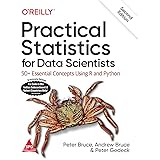Adjusted R-Square in Statistics
Adjusted R-Square in Statistics, In the realm of statistical analysis, linear regression models play a pivotal role in understanding the relationship between dependent and independent variables.
Two crucial metrics that help assess the performance of these models are R-squared (R2) and Adjusted R-squared (Adjusted R2).
Both these measures evaluate the goodness of fit of a linear regression model, providing insights into how well the model explains the variation in the dependent variable.
This article aims to delve deeper into the concepts of R-squared and Adjusted R-squared, their formulas, and their significance in the context of linear regression models.
What is R-squared (R2)?
R-squared, often denoted as R2, is a statistical measure that indicates the proportion of the variance for a dependent variable (Y) that can be explained by an independent variable (X) in a linear regression model.
In simpler terms, it quantifies the extent to which the regression model accounts for the fluctuations in the dependent variable.
R-squared values range between 0 and 1, with 1 signifying a perfect fit, where the model explains all the variation in the dependent variable.
A value of 0 indicates that the model fails to explain any variation in the dependent variable.
Higher R-squared values generally imply a better fit, suggesting that the model can predict the dependent variable more accurately.
Formula for R-squared: R2 = 1 - (SSR / SST)Here, SSR (Sum of Squared Residuals) is the sum of the squared differences between the actual dependent variable values and the predicted values based on the regression model.
SST (Total Sum of Squares) is the sum of the squared differences between the actual dependent variable values and their mean.
What is Adjusted R-squared (Adjusted R2)?
Adjusted R-squared, often denoted as Adjusted R2, is an extension of the R-squared concept. It adjusts the R-squared value based on the number of independent variables in the model.
The primary objective of Adjusted R2 is to penalize the model for adding more variables, especially if they do not contribute significantly to the explanation of the dependent variable’s variation.
Linear Interpolation in R-approx » Data Science Tutorials
The Adjusted R-squared value will always be less than or equal to the R-squared value. This occurs because Adjusted R2 considers the trade-off between the model’s complexity (number of independent variables) and its ability to explain the variation in the dependent variable.
Formula for Adjusted R-squared:
Adjusted R2 = 1 - [(1 - R2)(n - 1) / (n - k - 1)]Here, n represents the sample size, and k denotes the number of independent regressors or variables in the model, excluding the constant.
Example
Let’s consider a practical example to understand the application of R-squared and Adjusted R-squared.
Suppose a fund has a sample R-squared value close to 0.5, and it is offering higher risk-adjusted returns with a sample size of 50 and 5 predictors.
We can find the Adjusted R-squared value using the formula:
Adjusted R2 = 1 - [(1 - 0.52)(50 - 1)/(50 - 5 - 1)]
= 1 - (0.75) × 49/44
= 1 - 0.8352
= 0.1648In this case, the Adjusted R-squared value is 0.1648, which is less than the R-squared value of 0.5.
This indicates that although the model explains a considerable proportion of the dependent variable’s variation (R2 = 0.5), the addition of more variables might not be contributing significantly to the model’s overall performance.
Significance of R-squared and Adjusted R-squared
Both R-squared and Adjusted R-squared play a vital role in evaluating the performance of a linear regression model. They help in:
- Assessing the model’s predictive power: Higher R-squared and Adjusted R-squared values suggest that the model can predict the dependent variable more accurately.
- Comparing different models: Researchers and analysts can compare multiple models to select the one that best fits the data and explains the variation in the dependent variable.
- Identifying overfitting: By comparing R-squared and Adjusted R-squared values, one can identify if a model is overfitting, i.e., excessively complex and struggling to generalize to new data.
- Model simplification: Analysts can use Adjusted R-squared to decide whether to remove insignificant variables from the model, thereby improving its interpretability and reducing the chances of overfitting.
Conclusion
R-squared and Adjusted R-squared are indispensable tools for evaluating the performance of linear regression models.
While R-squared quantifies the proportion of the dependent variable’s variation explained by the model, Adjusted R-squared penalizes the model for adding unnecessary variables.
Understanding these measures and their formulas can significantly assist in model selection, comparison, and optimization, ultimately leading to more accurate predictions and insights.
Causal Conclusions and Control of Confounding Variables (finnstats.com)




